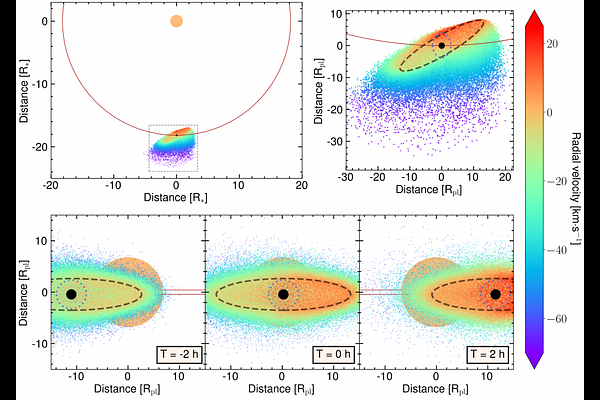Continuous helium absorption from the leading and trailing tails of WASP-107b

Continuous helium absorption from the leading and trailing tails of WASP-107b
Vigneshwaran Krishnamurthy, Yann Carteret, Caroline Piaulet-Ghorayeb, Jared Splinter, Dhvani Doshi, Michael Radica, Louis-Philippe Coulombe, Romain Allart, Vincent Bourrier, Nicolas B. Cowan, David Lafrenière, Loïc Albert, Lisa Dang, Ray Jayawardhana, Doug Johnstone, Lisa Kaltenegger, Adam B. Langeveld, Stefan Pelletier, Jason F. Rowe, Pierre-Alexis Roy, Jake Taylor, Jake D. Turner
AbstractThe detection of helium escaping the atmosphere of exoplanets has revolutionized our understanding of atmospheric escape and exoplanetary evolution. Using high-precision spectroscopic observations from the James Webb Space Telescope (JWST) NIRISS-SOSS mode, we report the detection of significant helium absorption during the pre-transit phase of WASP-107b (17$\sigma$), as well as in the transit and post-transit phases. This unique continuous helium absorption begins approximately 1.5 hours before the planet's ingress and reveals the presence of an extended thermosphere. The observations show a maximum transit depth of 2.395$\% \pm$ 0.01$\%$ near the helium triplet (36$\sigma$; at NIRISS-SOSS resolution $\sim$ 700). Our ellipsoidal model of the planetary thermosphere matches well the measured light curve suggesting an outflow extending to tens of planetary radii. Furthermore, we confidently detect water absorption (log10 H2O=-2.5 $\pm$ 0.6), superimposed with a short-wavelength slope which we attribute to a prominent signature from unocculted stellar spots (5.2$\sigma$), rather than a small-particle haze slope. We place an upper limit on the abundance of K (log10 K$<$-4.86, or K/H$<$ 75$\times$ stellar) at 2$\sigma$, which is consistent with the O/H super-solar metallicity estimate. This study underscores the transformative potential of JWST for tracing atmospheric and mass-loss processes, while offering a benchmark for future studies targeting helium escape and its implications for planetary evolution.